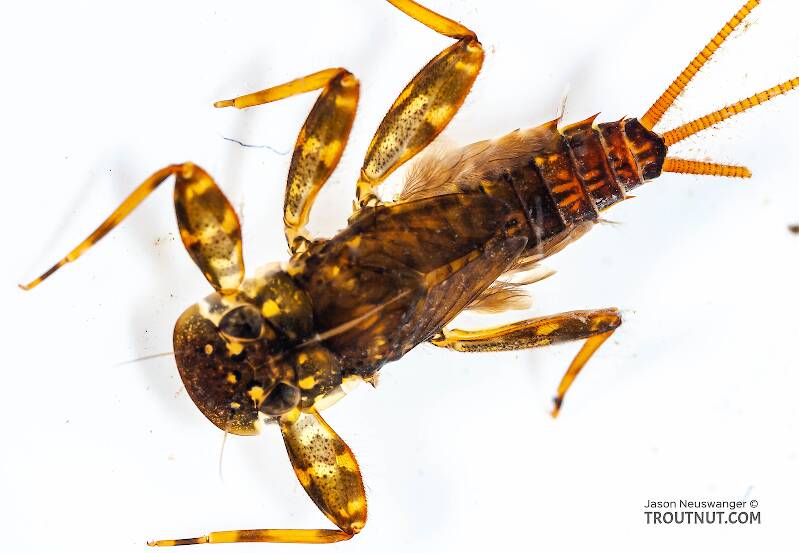
Salmonflies
Pteronarcys californica
The giant Salmonflies of the Western mountains are legendary for their proclivity to elicit consistent dry-fly action and ferocious strikes.


Mayfly Species Stenonema femoratum (Cream Cahills)
Where & when
Time of year : Early May to early September, peaking in early June
Preferred waters: Lakes, warmwater streams, and warm trout streams
In 143 records from GBIF, adults of this species have mostly been collected during June (20%), July (20%), May (18%), August (18%), April (13%), and September (6%).
In 84 records from GBIF, this species has been collected at elevations ranging from 282 to 9318 ft, with an average (median) of 2904 ft.
Species Range
Nymph biology
Current speed: Slow to medium
Substrate: Stones, sunken logs, and leaf drift
Environmental tolerance: Quite tolerant of pollution; thrives in warm water
Physical description
Most physical descriptions on Troutnut are direct or slightly edited quotes from the original scientific sources describing or updating the species, although there may be errors in copying them to this website. Such descriptions aren't always definitive, because species often turn out to be more variable than the original describers observed. In some cases, only a single specimen was described! However, they are useful starting points.
Male Spinner
Wing length: 9-13 mm
A species allied to S. tripunctatum (now a synonym of Stenonema femoratum); abdominal tergites 2-6 yellowish brown, sternites yellow-white; black median spot and lateral dashes on tergites posteriorly; hind wing dark-tipped; cross veins crowded at bulla.
Head reddish brown; frontal margin paler. Purplish spot on median carina; a small black dot at lower corner of eye, another below antenna; purplish brown median spot on vertex, halfway to posterior margin. Antenna dark brown basally, tips pale. Thorax largely dark red-brown. Median area of pronotum blackish, likewise posterior margin; oblique purplish brown streak laterally, halfway to lateral margin. A wide purplish black streak extends down from base of fore wing across prothorax and fore coxa. Below each wing root, a similar dark oblique streak on pleura. Large areas on pleura anterior to wing root and below wings. Tip of mesonotal scutellum yellowish white; sternum paler red-brown. Legs yellowish. Fore femur tinged with yellow-brown; a small black spot at base; median purple-red band, apical dark brown one; tip of fore tibia and tarsal joinings blackish; distal tarsal joint and claws smoky brown. Basal joint of fore tarsus more than 1/2 length of second. Median and apical bands on middle and hind femora; tips of tibiae and tarsal joinings dark brown, last two tarsal joints tinged with smoky brown.
Wings hyaline, often with faint milky tinge. Cross veins crowded in first six spaces at bulla; usually 3 in costal space, and 4 to 5 in subcostal and radial spaces. These veins dark-margined, and wing membrane between them brown-tinged, forming a curved dark streak in wing, as in Stenonema pudicum. Cross veins of costal margin thickened, many of them margined; humeral vein especially heavy; others in fore wing dark brown, many narrowly margined, but not as heavy as costals. Longitudinal veins of costal margin yellow, others in fore wing brown; in hind wing, yellow. Apex and upper portion of outer margin of hind wing heavily brown-tinged. Abdominal tergites 2-6 yellowish brown dorsally, tinged with brown posteriorly and laterally; at median line of each tergite, on posterior margin, a black dot, and lateral dark streaks laterad of this, one on each side. Spiracular dots faintly visible, on 2-7. Sternites 2-6 yellowish, the antero-lateral and lateral margins narrowly brownish. Segments 7-10 rather deep red-brown. Genitalia quite similar to S. tripunctatum, but the penes with stronger median spines, the outer portions more wedge-shaped, the inner margins more distinctly incurved (see fig. 91). Tails pale smoky at base, pale yellowish in middle area, dusky at tips; joinings purplish brown, alternate joinings wider.
Described as S. birdi
Body length 11 mm, wing length 12-13 mm
A species of the tripunctatum group (now a synonym of Stenonema femoratum); closely allied to S. femoratum but lacking the dark border on hind wing.
Head and thorax as in femoratum. Eyes very slightly smaller and set back somewhat further on angles of head; bluish black in holotype, greyish blue in some of paratypes (in alcohol). Legs pale reddish brown, somewhat darker than in femoratum, but with similar markings. Basal joint of fore tarsus slightly more than 1/3 but distinctly less than 1/2 the length of the second (in femoratum, slightly more than 1/2). Wings rather narrower in proportion to length than in femoratum. Venation slightly darker brown; cross veins much less distinctly margined. Cross veins crowded at bulla in first three spaces, but much less crowded behind third place than in that species; no faint dark band in this region. Basal costal cross veins 4 to 5 in number, tending to be slightly curved (not so in femoratum). Stigmatic cross veins rather more numerous, aslant, occasionally one or two are forked; this area stained as in femoratum. Hind wing not darkened at apex nor along outer margin.
Abdominal segments red-brown, darker than in femoratum; sternites little if any paler than tergites. Marked very similar to femoratum, but no obscured dark stigmatic spots. Tracheae quite distinctly outlined in greyish black. Pleural fold narrowly pale. Tails light reddish brown, darker at joinings, alternate joinings wider. Genitalia very much as in femoratum.
Described as S. scitulum
Body length 8-8.5 mm, wing length 9 mm
A species of the tripunctatum group (now a synonym of Stenonema femoratum); very close to tripunctatum, but with hind wing distinctly dark-margined; eyes large.
Eyes considerably larger relatively than in typical tripunctatum; almost contiguous apically. Head and thorax yellowish; short black submedian streaks on pronotum; blackish markings on pleura as in tripunctatum. Legs yellowish; median and apical bands on all femora, median band on hind femur may be very faint. Apex of fore tibia, all tarsal joinings and claws blackish. Basal joint of fore tarsus fully 1/2 as long as second. Wings very similar to tripunctatum, except that hind wing is distinctly blackish brown on outer margin, most evident at and below tip. Abdominal segments 2-7 hyaline, white; dark streaks on posterior margins of tergites 8-10 in tripunctatum; no stigmatic marks. Segments 8-10 opaque; tergites pale red-brown, sternites paler. Tails white, alternate joinings purplish black. Genitalia very similar to tripunctatum. Female very similar to male. Wing 10-12 mm. in length.
Described as S. tripunctatum
Body length 9-11 mm, wing length 12-13 mm
Thorax largely brown; abdomen paler, one median and two lateral black transverse dashes on posterior margins of tergites; hind wing not dark-margined; penes distinctly L-shaped.
Head yellowish, with red-brown shading between ocelli and on vertex; a small dark dot on each side of median carina, slightly below level of antennae. Eyes large, almost contiguous apically. Thorax largely red-brown; a dark median streak on anterior portion of pronotum, sometimes divided by a pale line; an oblique lateral dark streak on pronotum, about halfway to lateral margin. A purplish black streak extends from base of fore trochanter to posterior margin of prothorax. Dark shading anterior to scutellum on mesonotum, and on postero-lateral margins; scutellum somewhat paler than remainder of mesonotum. Pleura pale red-brown; a prominent dark spot below fore wing above base of middle leg; a less conspicuous short dark streak below hind wing. Small dark dot on each trochanter. Metanotum largely dark red-brown. Sternum paler red-brown, anterior portion of mesosternum yellowish. Legs yellowish. Fore femur tinged with yellowish brown; median and apical dark bands; apex of tibia blackish; claw and distal tarsal joint smoky, tarsal joinings blackish. Basal joint of fore tarsus about 1/2 the length of the second. Middle and hind femora with dark median and apical bands; tips of tibiae and tarsal joinings dark brown; distal tarsal joints smoky. Wings hyaline; humeral cross vein thickened, blackish; costo-apical space with yellowish tinge, distinct purplish red stain in stigmatic area, in costal and subcostal spaces. Longitudinal veins yellowish; cross veins blackish brown; those in costal margin thickened, very prominent; in anal region and along outer margin of fore wing, finer, somewhat paler. Cross veins at bulla tend to become crowded, so that there are usually 3 in the costal, and 3 or 4 each in the subcostal and radial spaces at this point. In hind wing veins are fine, pale; no distinct dark outer margin as in the allied Stenonema femoratum and in scitulum (now a synonym of S. femoratum).
Abdominal segments 1-7 pale whitish or yellowish, sometimes with slight brownish tinge. On posterior margin of each tergite, a dark transverse streak at median line, and two similar dark lateral streaks; spiracular dots present, near end of lateral dark streak. Segments 8-10 similar to thorax in color. Genitalia of the tripunctatum type (now a synonym of Stenonema femoratum) (see fig. 91, femoratum); penes almost straight on apical margin; inner margin incurved, median spines well developed. Tails pale, joinings purplish black; alternate nearer joinings wider. The three black dashes on posterior margins of tergites distinguish this species from others except S. femoratum, scitulum (now a synonym of S. femoratum) and birdi (now synonym of S. femoratum). The first named species is much darker, with dark-tipped hind wings; scitulum is small and pale, with dark-tipped hind wings; birdi brownish, hind wing as in tripunctatum. What appears to be merely a color-phase of this species is quite common; in this phase, the thorax is pale creamy or clay-colored, abdominal segments 1-7 almost pure white. Other markings are similar to the darker phase just described.
Female Spinner
Specimens of the Mayfly Species Stenonema femoratum
1 Nymph
Start a Discussion of Stenonema femoratum
References
- Fauceglia, Ted. 2005. Mayflies . Stackpole Books.
- Knopp, Malcolm and Robert Cormier. 1997. Mayflies: An Angler's Study of Trout Water Ephemeroptera . The Lyons Press.
- Leonard, Justin W. and Fannie A. Leonard. 1962. Mayflies of Michigan Trout Streams. Cranbrook Institute of Science.
- Merritt R.W., Cummins, K.W., and Berg, M.B. 2019. An Introduction to the Aquatic Insects of North America (Fifth Edition). Kendall/Hunt Publishing Company.
- Needham, James G., Jay R. Traver, and Yin-Chi Hsu. 1935. The Biology of Mayflies. Comstock Publishing Company, Inc.
Mayfly Species Stenonema femoratum (Cream Cahills)
Species Range
Common Names
Resources
- NatureServe
- Integrated Taxonomic Information System
- Global Biodiversity Information Facility
- Described by Say (1823)


